Comparison of Cooling Different Parts in a High Pressure Ratio Centrifugal Compressor
Abstract
:1. Introduction
2. Numerical Approach
2.1. Compressor Geometry
2.2. Grid Generation
2.3. Boundary Conditions
2.4. Numerical Methodology
2.4.1. Advection Discretization Method
2.4.2. Conjugate Heat Transfer
2.5. Numerical Model Validation
3. Results and Discussion
3.1. Effects on the Pressure Ratio
3.2. Effects on the Impeller Temperature
3.3. Effects on the Polytropic Efficiency
4. Conclusions and Remarks
Acknowledgments
Author Contributions
Conflicts of Interest
Nomenclature
| D | Impeller diameter (mm) |
| h | Specific enthalpy (J·kg−1) |
| H | Total Enthalpy (J) |
| m | Mas flow rate (kg·s−1) |
| n | Rotational speed (rpm) |
| N | Rotational speed |
| p | Pressure (kPa) |
| PR | Pressure ratio |
| pk | Shear production of turbulence (kg·m−1·s−3) |
| p’ | Corrected pressure (= p + 2ρk/3) |
| q” | Heat flux (W·m−2) |
| q | Cooling power (W) |
| Q | Heat transfer per mass flow rate (kJ·kg−1) |
| R | Gas constant |
| Re | Reynolds number |
| s | Entropy (J·kg−1·K−1) |
| Sm | Momentum source term |
| SE | Energy source term |
| T | Temperature (K) |
| U | Mean velocity (m·s−1) |
| u | Velocity fluctuation (m·s−1) |
| W | Work input (kW) |
| y+ | Dimensionless wall distance |
| Z | Number of blades or vanes |
| Greek symbols | |
| ∇ | Nabla sign |
| µ | Air viscosity (kg·s−1·m−1) |
| λ | Thermal conductivity (W·K−1·m−1) |
| η | efficiency |
| Density (kg·m−3) | |
| τ | Shear stress (N·m−2) |
| Subscriptions | |
| adia | Adiabatic |
| c | Cooled process |
| eff | Effective viscosity |
| p | Polytropic |
| s | Isentropic |
| t | Turbulent |
| 0 | Stagnation condition |
| 1 | Inlet |
| 2 | Outlet |
| θ | Tangential direction |
References
- Tamaki, H.; Unno, M.; Kawakubo, T.; Hirata, Y. Aerodynamic Design of Centrifugal Compressor for AT14 Turbocharger. IHI Eng. Rev. 2010, 43, 70–76. [Google Scholar]
- Zheng, X.; Jin, L.; Du, T.; Gan, B.; Liu, F.; Qian, H. Effect of temperature on the strength of a centrifugal compressor impeller for a turbocharger. Proc. Inst. Mech. Eng. Part C J. Mech. Eng. Sci. 2012, 227, 896–904. [Google Scholar] [CrossRef]
- Baines, N.C. Fundamentals of turbocharging; Cncepts NREC: White River Junction, VT, USA, 2005. [Google Scholar]
- Krain, H.; Hoffmann, B. Improved High Pressure Ratio Centrifugal Compressor. In Proceedings of the ASME Turbo Expo 2007: Power for Land, Sea, and Air, Montreal, QC, Canada, 14–17 May 2007; pp. 1–9.
- Krain, H.; Hoffmann, B. Flow Study of a Redesigned High-Pressure-Ratio Centrifugal Compressor. J. Propuls. Power 2008, 24, 1117–1123. [Google Scholar] [CrossRef]
- Zhang, C.; Deng, Q.; Feng, Z. Study on Aerodynamic Redesign of a High Pressure Ratio Centrifugal Compressor. In Proceedings of the ASME Turbo Expo 2010, Glasgow, UK, 14–18 June 2010; pp. 1027–1040.
- Zheng, Q.; Sun, Y.; Li, S.; Wang, Y. Thermodynamic Analyses of Wet Compression Process in the Compressor of Gas Turbine. J. Turbomach. 2003, 125, 489–496. [Google Scholar] [CrossRef]
- Sanaye, S.; Tahani, M. Analysis Of Gas Turbine Operating Parameters With Inlet Fogging And Wet Compression Processes. Appl. Therm. Eng. 2010, 30, 234–244. [Google Scholar] [CrossRef]
- Bhargava, R.; Meher-Homji, C.B. Parametric Analysis of Existing Gas Turbines With Inlet Evaporative and Overspray Fogging. In Proceedings of the ASME Turbo Expo 2002, Amsterdam, The Netherlands, 3–6 June 2002; pp. 387–401.
- Shibata, T.; Takahashi, Y.; Hatamiya, S. Inlet Air Cooling With Overspray Applied to a Two-Stage Centrifugal Compressor. In Proceedings of the ASME Turbo Expo 2008, Berlin, Germany, 9–13 June 2008; pp. 207–217.
- Chaker, M.; Meher-homji, C.B. Inlet Fogging of Gas Turbine Engines: Climatic Analysis of Gas Turbine Evaporative Cooling Potential of International Locations. In Proceedings of ASME Turbo Expo 2002, Amsterdam, The Netherlands, 3–6 June 2002; pp. 1–16.
- Brun, K.; Kurs, R. Inlet Fogging and Overspray Impact on Industrial Gas Turbine Life and Performance. In Proceedings of 20th Symposium of the Industrial Application of Gas Turbines Committee, Banff, AB, Canada, 21 Octobre 2013.
- Ameri, M.; Hejazi, S.H. The Study Of Capacity Enhancement Of The Chabahar Gas Turbine Installation Using An Absorption Chiller. Appl. Therm. Eng. 2004, 24, 59–68. [Google Scholar] [CrossRef]
- Moosania, S.M.; Zheng, X. Performance Improvement Of A High Pressure Ratio Centrifugal Compressor By Integrated Cooling. Proc. Inst. Mech. Eng. Part G J. Aerosp. Eng. 2015. [Google Scholar] [CrossRef]
- Lei, V.-M.; Kawakubo, T. A Fast Method For Conjugate Heat Transfer Analysis Of Centrifugal Compressor. In Proceedings of International Mechanical Eng. Congress and Exposition, Seattle, WA, USA, 11–15 November 2007; Paper No. IMECE2007-41368. pp. 699–706.
- Jaluria, Y.; Atluri, S.N. Computational heat transfer. Comput. Mech. 1994, 14, 385–386. [Google Scholar] [CrossRef]
- Bohn, D.; Heuer, T.; Kusterer, K. Conjugate Flow and Heat Transfer Investigation of a Turbo Charger. J. Eng. Gas Turbines Power 2005, 127, 663–669. [Google Scholar] [CrossRef]
- Yamagata, A.; Nagai, S.; Nakano, K.; Kawakubo, T. Prediction and measurement of turbocharger compressor wheel temperature. In Proceedings of 8th International Conference on Turbochargers and Turbocharging, London, UK, 17–18 May 2006; pp. 3–13.
- Menter, F.R. Two-equation eddy-viscosity turbulence models for engineering applications. AIAA J. 1994, 32, 1598–1605. [Google Scholar] [CrossRef]
- Bulat, M.P.; Bulat, P.V. Comparison of turbulence models in the calculation of supersonic separated flows. World Appl. Sci. J. 2013, 27, 1263–1266. [Google Scholar]
- Verstraete, T.; Van den Braembussche, R.A. A novel method for the computation of conjugate heat transfer with coupled solvers. In Proceedings of International Symposium on Heat Transfer in Gas Turbine Systems, Antalya, Turkey, 9–14 August 2009.
- Krain, H.; Hoffmann, B.; Pak, H. Aerodynamics of a Centrifugal Compressor Impeller with Transonic Inlet Conditions. In Proceedings of ASME Summer Meeting, Washington DC, USA, 21–25 June 1998; pp. 1–9.
- Broadbent, E. Flows With Heat Addition. Prog. Aerospace Sci. 1976, 17, 93–108. [Google Scholar] [CrossRef]
- Casey, M.V.; Fesich, T.M. The Efficiency of Turbocharger Compressors With Diabatic Flows. J. Eng. Gas Turbines Power 2010, 132, 72302. [Google Scholar] [CrossRef]
- Oldrich, J. Advanced Polytropic Calculation Method of Centrifugal Compressor. In Proceedings of the ASME 2010 International Mechanical Engineering Congress and Exposition, Vancouver, BC, Canada, 12–18 November 2010; pp. 123–131.
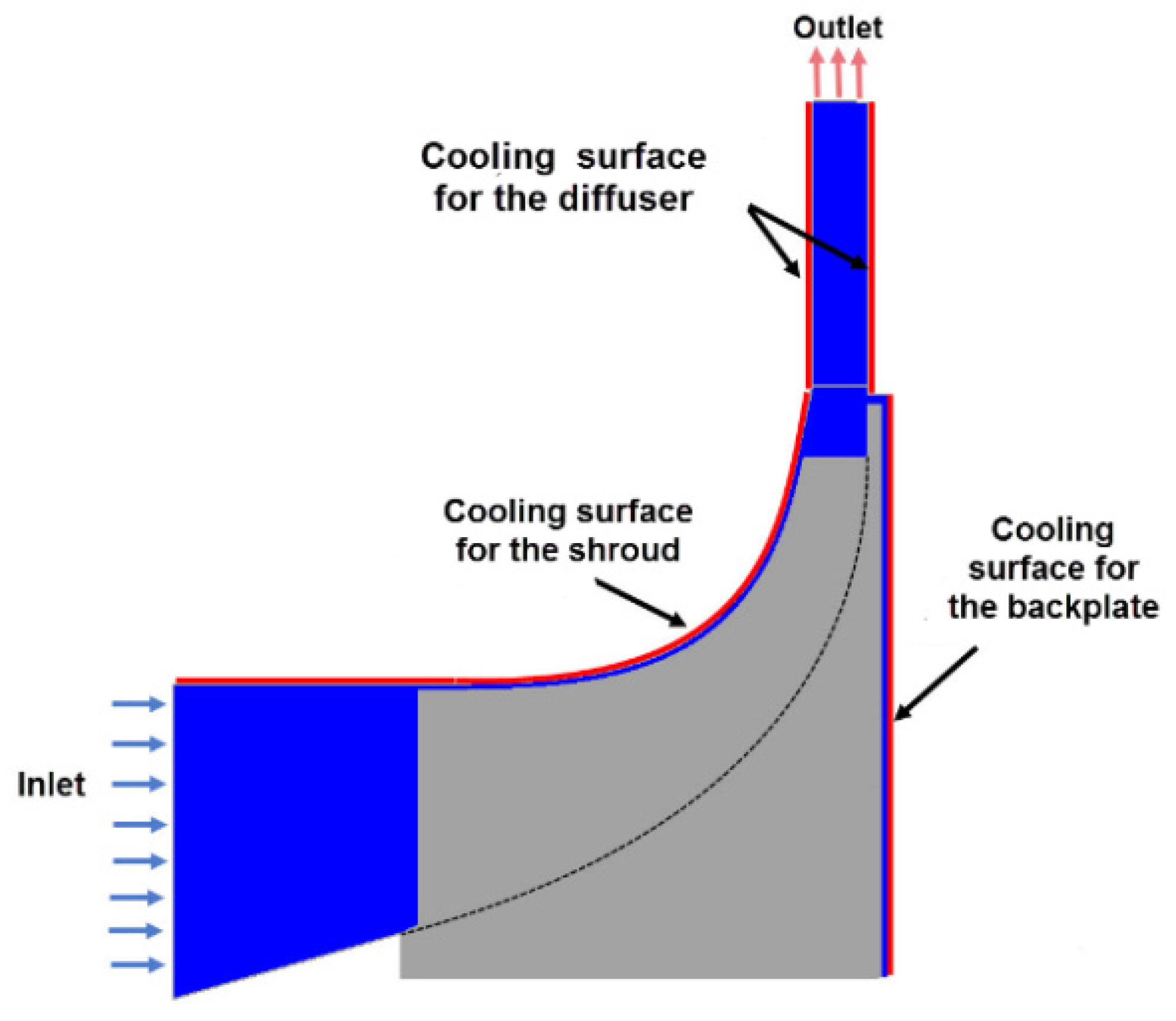
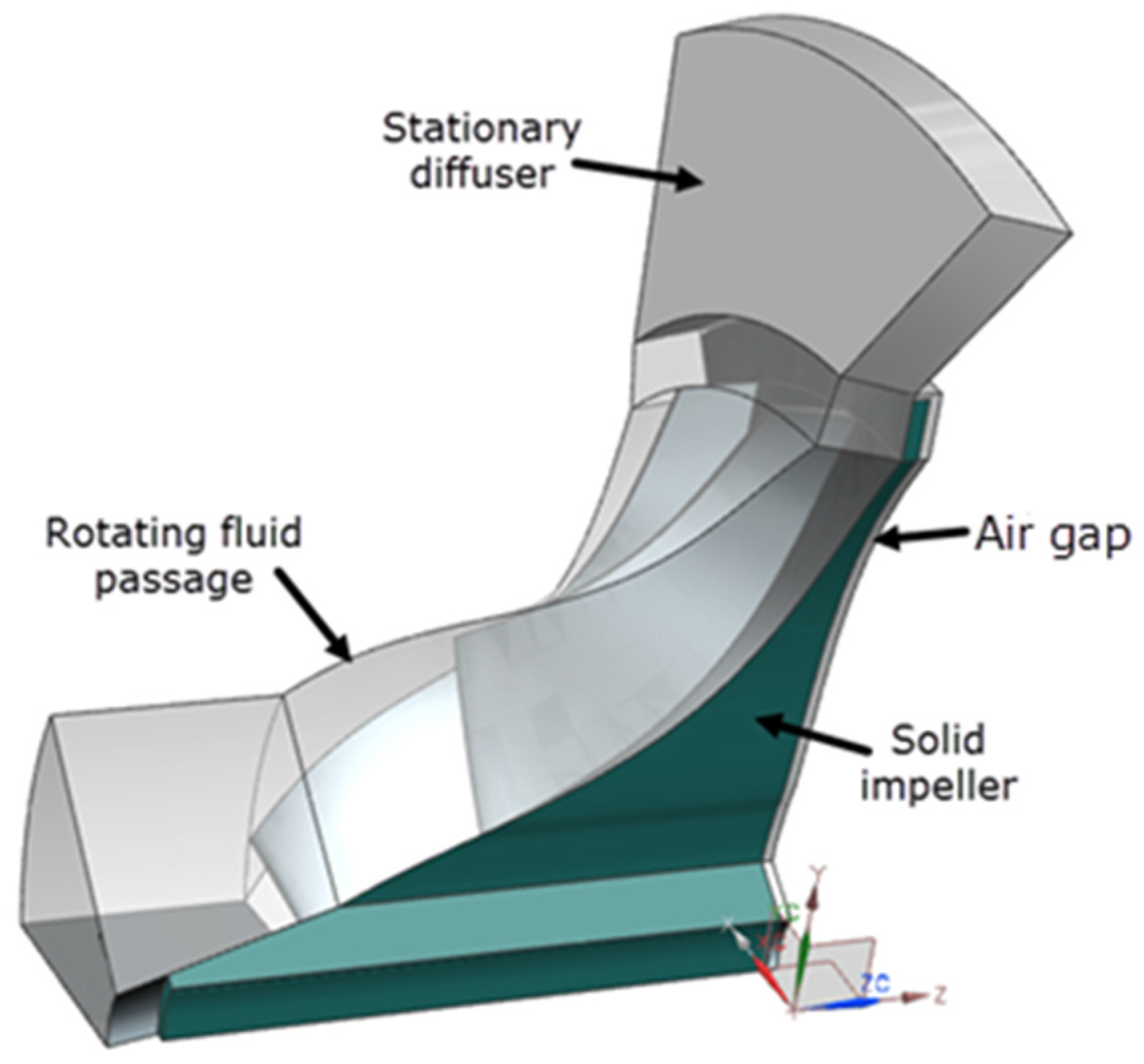
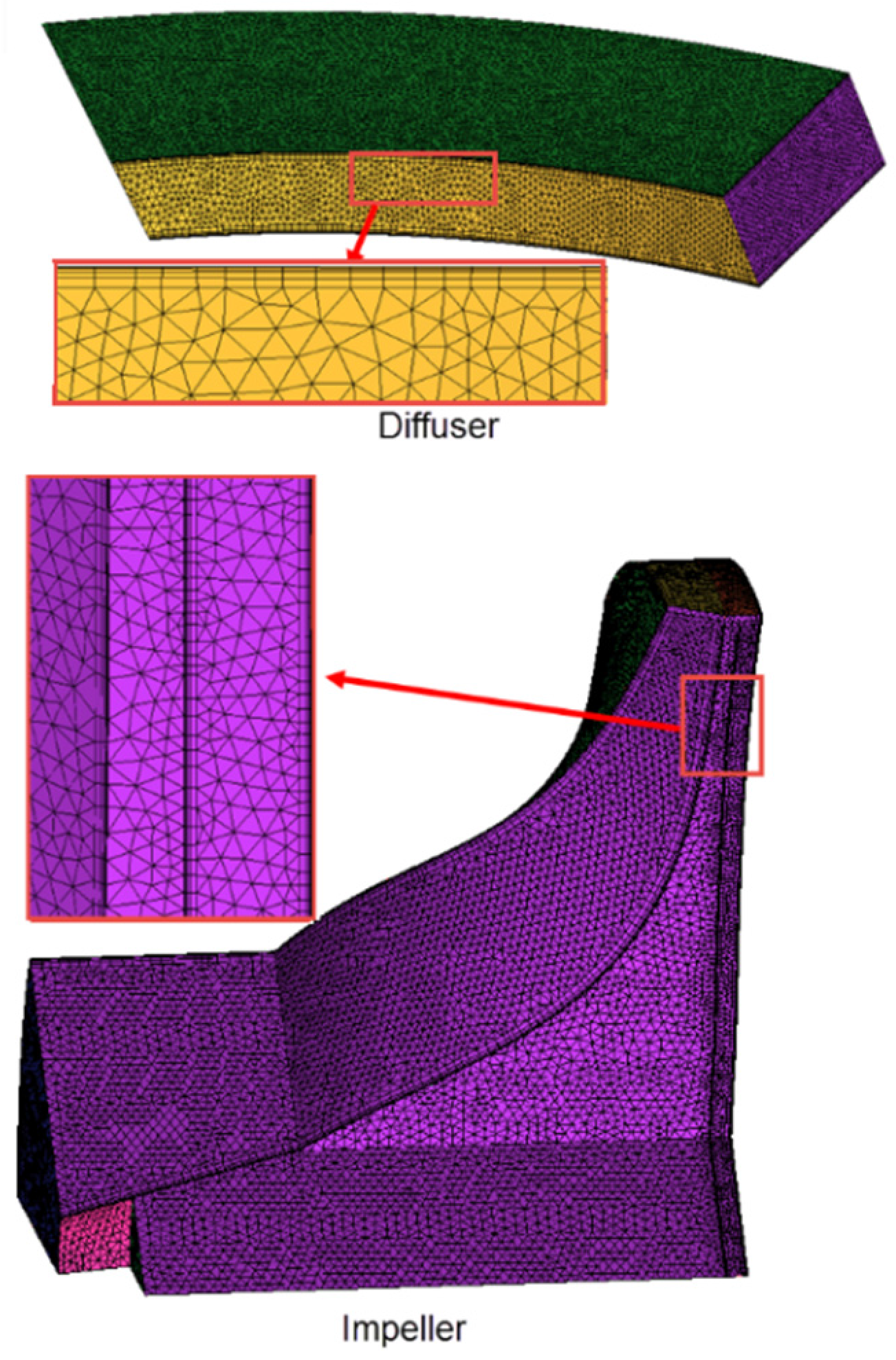
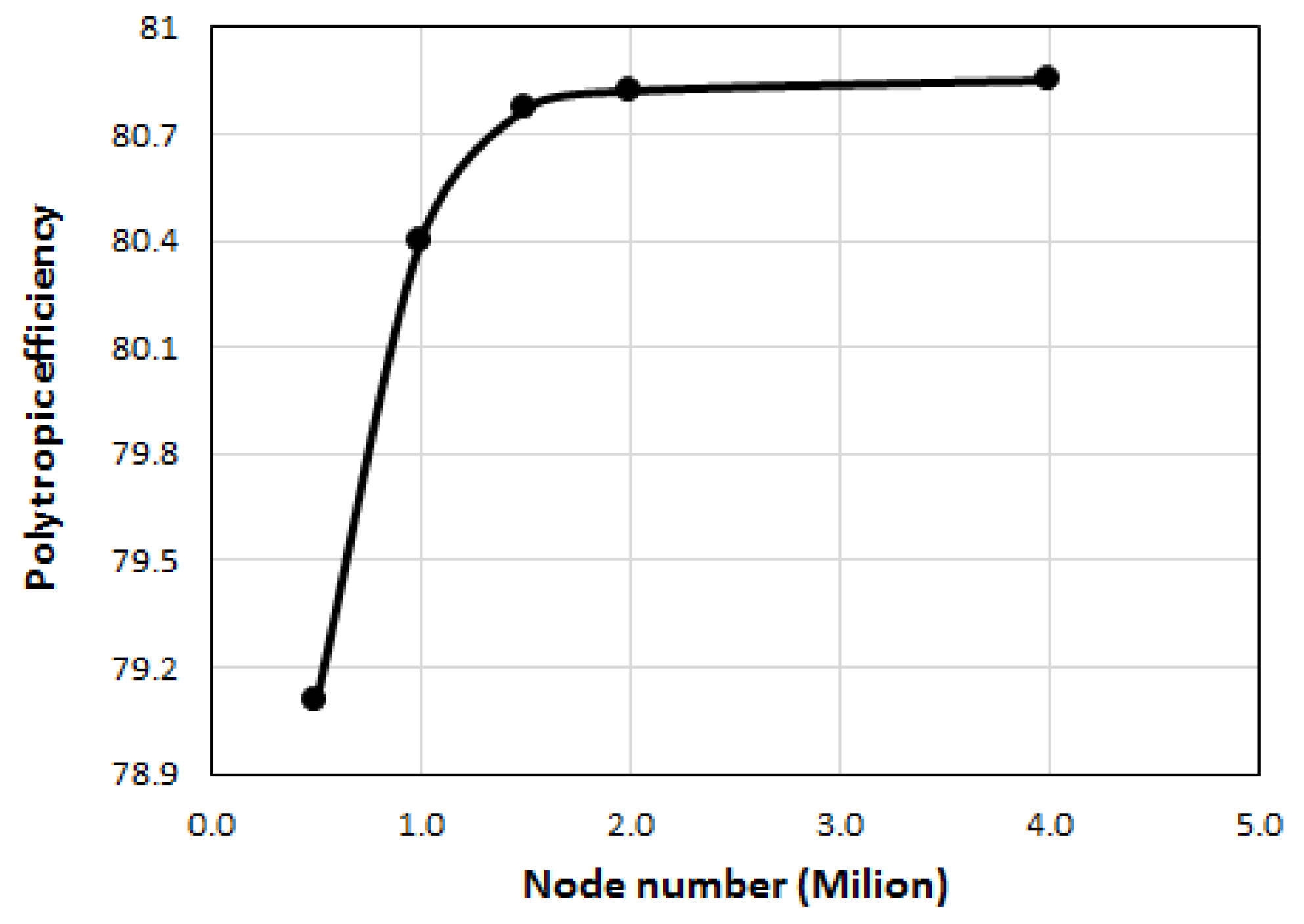

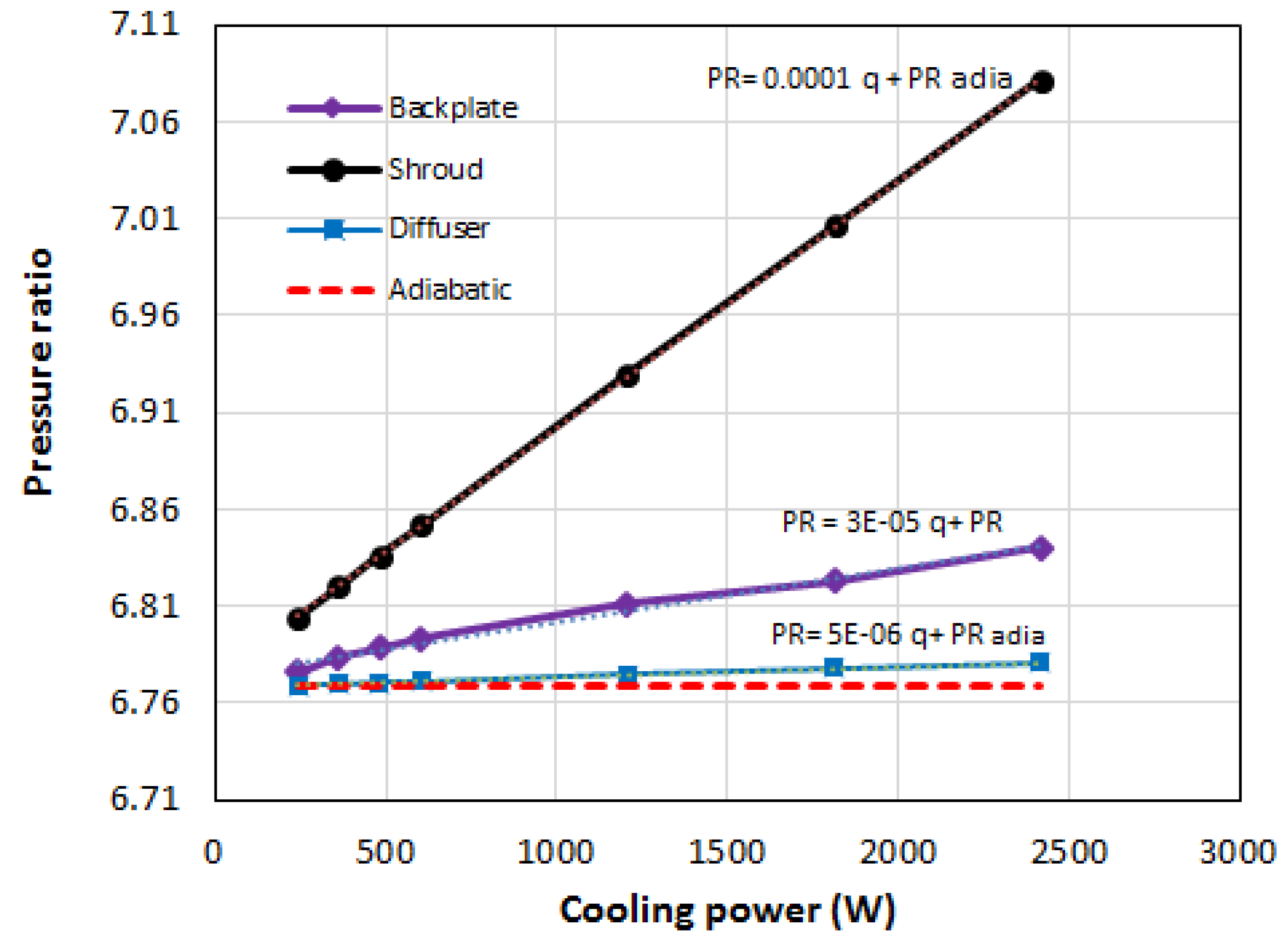
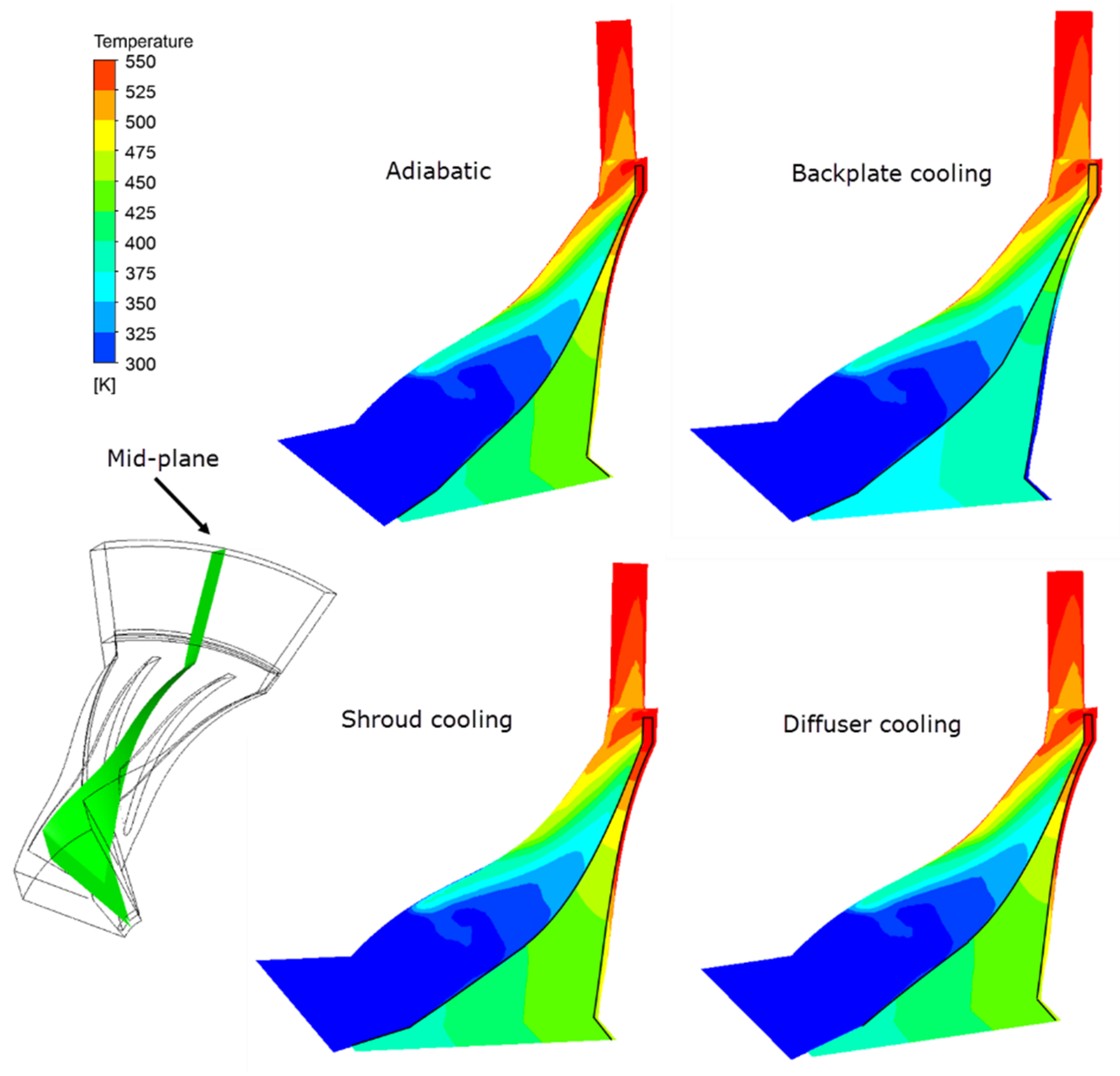

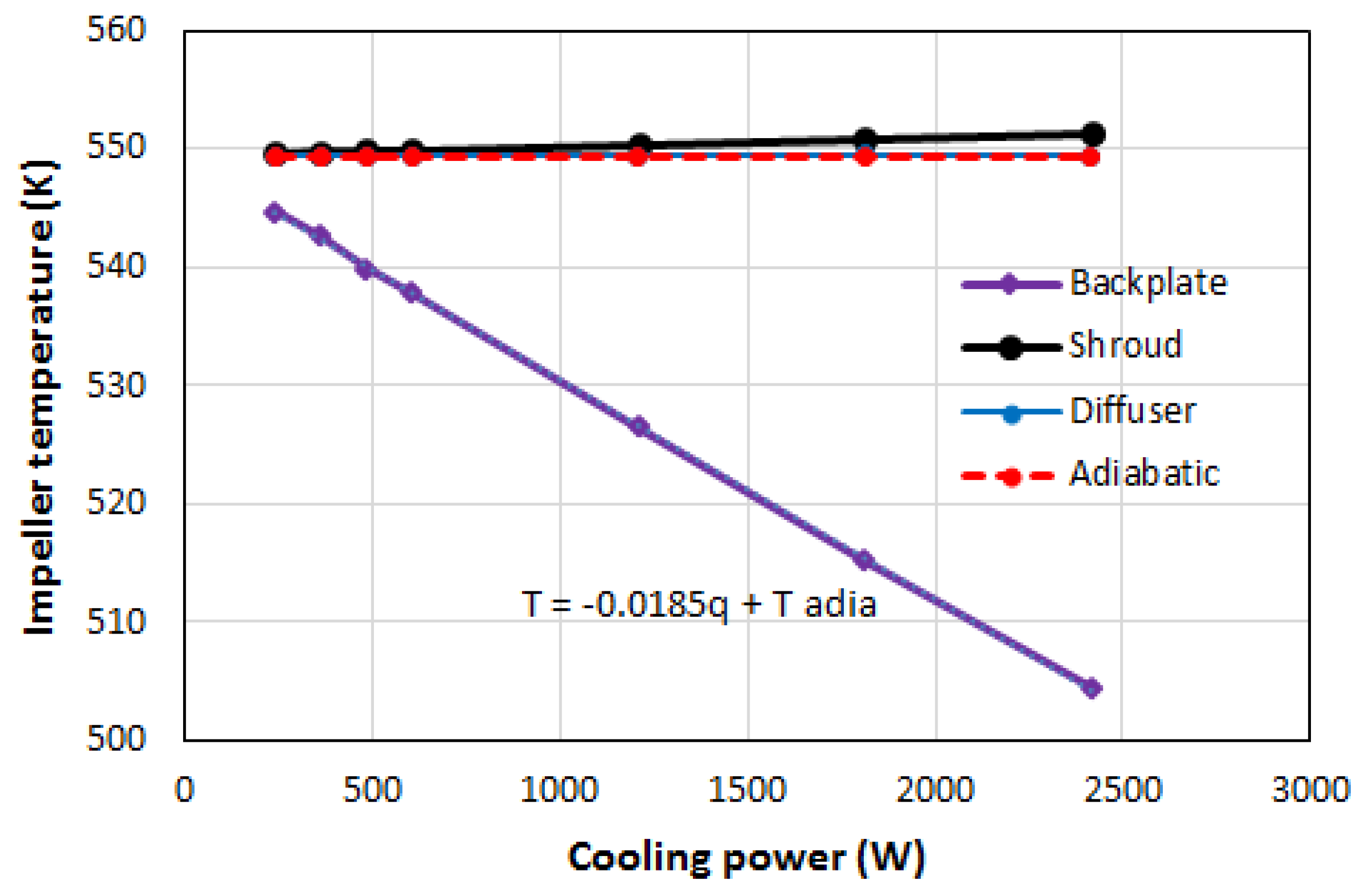
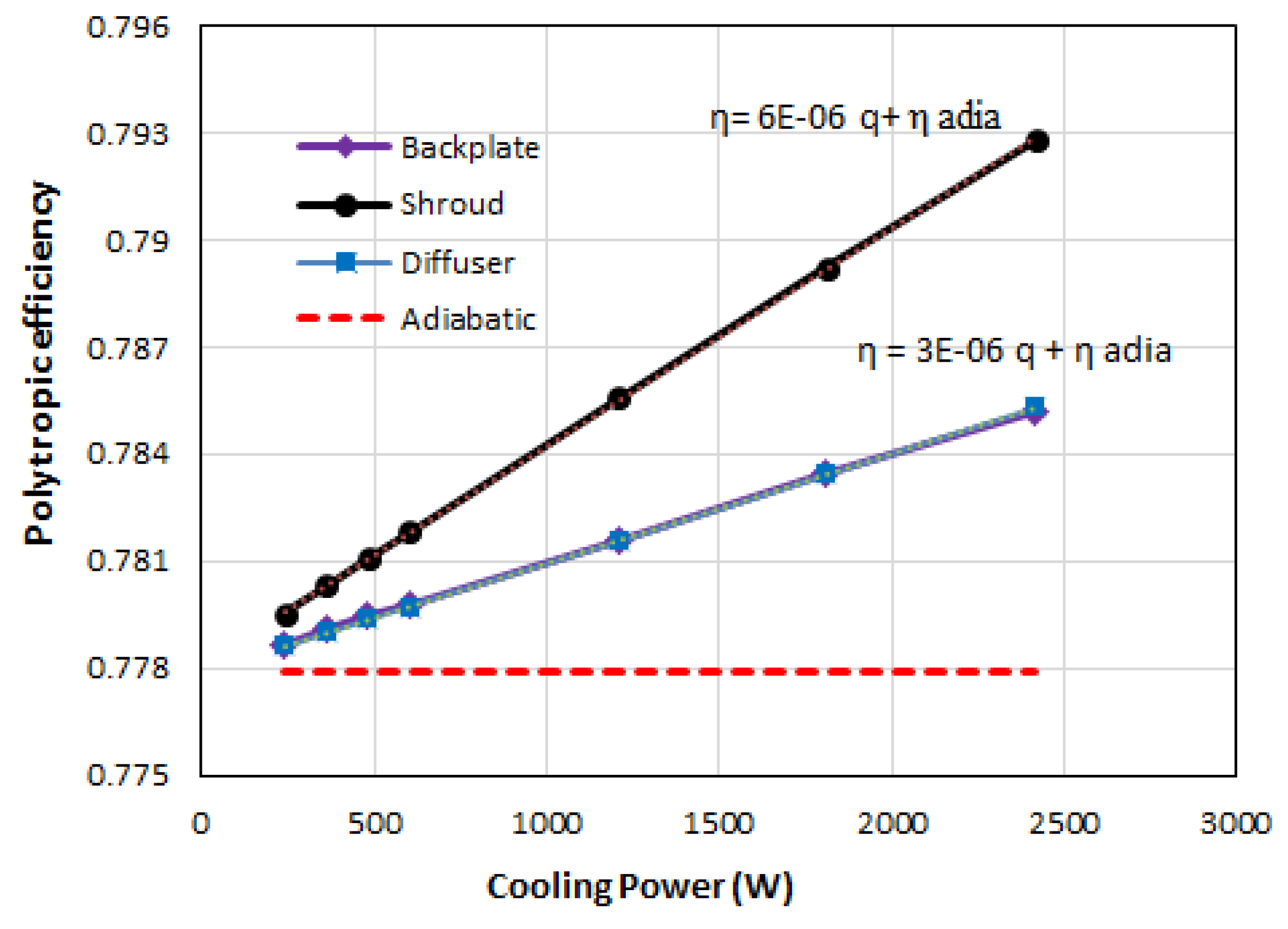
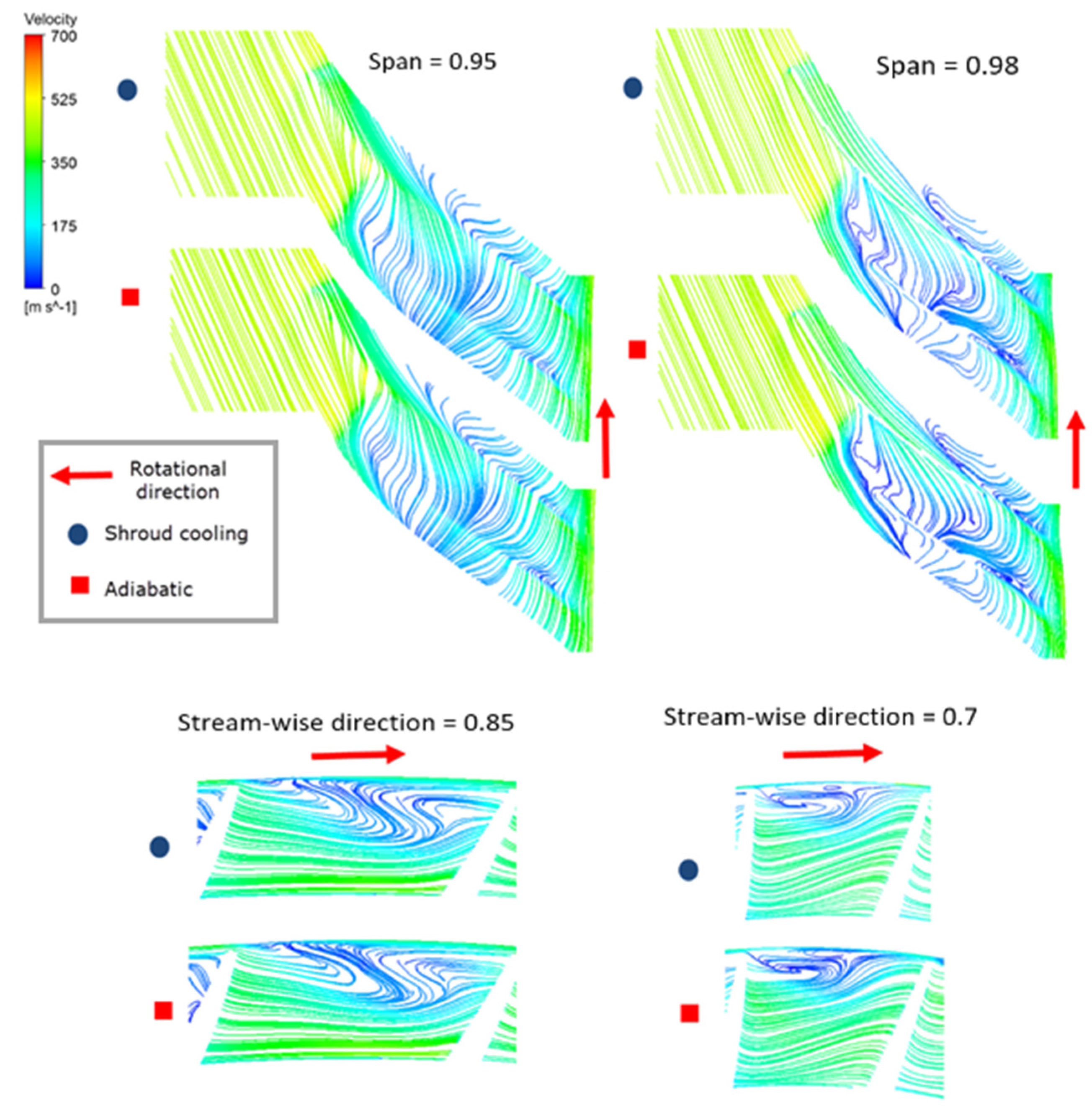
| Parameters | Values and Units |
|---|---|
| n (rotational speed) | 110,000 rpm |
| m (mass flow rate) | 0.7 kg·s−1 |
| Z (blade number) | 9 + 9 |
| D2 (impeller diameter) | 120 mm |
| W (work input) | 211.76 kW |
| Tip clearance | 0.5 mm |
| Air gap width | 1 mm |
| Blade inlet angle | 60° |
| Back sweep | 40° |
| Reynolds number | 4.96 × 102 |
| Cooling Wall | Cooling Power (W) | Work Input (W) | Pressure Ratio | Efficiency |
|---|---|---|---|---|
| Back plate cooling | 2415.978 | 212,922.4764 | 6.83992 | 0.785197 |
| Shroud cooling | 2415.978 | 215,355.0418 | 7.08167 | 0.792815 |
| Diffuser cooling | 2415.978 | 211,545.8032 | 6.78116 | 0.785338 |
| Adiabatic | 0 | 211,763.3036 | 6.76869 | 0.7779 |
© 2016 by the authors; licensee MDPI, Basel, Switzerland. This article is an open access article distributed under the terms and conditions of the Creative Commons Attribution (CC-BY) license (http://creativecommons.org/licenses/by/4.0/).
Share and Cite
Moosania, S.M.; Zheng, X. Comparison of Cooling Different Parts in a High Pressure Ratio Centrifugal Compressor. Appl. Sci. 2017, 7, 16. https://doi.org/10.3390/app7010016
Moosania SM, Zheng X. Comparison of Cooling Different Parts in a High Pressure Ratio Centrifugal Compressor. Applied Sciences. 2017; 7(1):16. https://doi.org/10.3390/app7010016
Chicago/Turabian StyleMoosania, S. Mostafa, and Xinqian Zheng. 2017. "Comparison of Cooling Different Parts in a High Pressure Ratio Centrifugal Compressor" Applied Sciences 7, no. 1: 16. https://doi.org/10.3390/app7010016
APA StyleMoosania, S. M., & Zheng, X. (2017). Comparison of Cooling Different Parts in a High Pressure Ratio Centrifugal Compressor. Applied Sciences, 7(1), 16. https://doi.org/10.3390/app7010016







